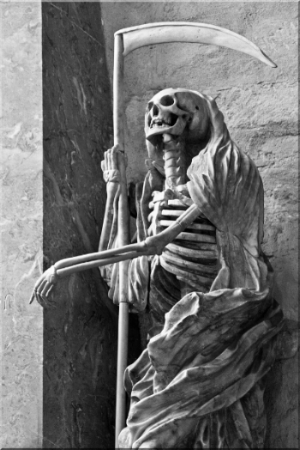By C.W.S.
An Angel of Death is defined by their role as a medical professional and their use of this role to kill those under their care for various psychological reasons.
Quietly terrifying, this type of crime strikes the most vulnerable populations, especially the elderly and infants: those who cannot speak out and cannot stop the abuse. It’s hard to imagine that a place where one goes to heal can be turned into just the opposite, a place that kills people before their time and without their consent.
Attempting to find the origin of the term ‘Angel of Death’ proves difficult. While there is no Angel of Death specifically mentioned in the Old or New Testaments, there is an angel that has come to be known as such. Azrael, who’s Hebrew name translates to “Help of God,” or “One whom God Helps.” This angel, though not considered canonical, has been known in lore to be the one who is forever writing in a large book and then forever erasing what he writes. He writes the birth of a man, and then erases the name of the man at death.
More likely, the idea of the modern Angel of Death comes from many testimonies over time by people from various religious backgrounds. Many of those who have had near-death experiences claim to have seen an angel-like being or beings that had come to facilitate their passage to the other side. The most popular modern representation of this being is the Grim Reaper, the skeleton cloaked in a black holding a scythe. These beings are considered personifications of death; they represent our attempt as mortals to make death into an understandable form.
These types of serial killers take the power of death into their own hands, decidedly ‘playing God,’ likening them to these religious and psychological characters. These victims are almost never known personally to their killer, instead they are used as pawns in their strange grandiose delusions.
Investigators and psychologists have illustrated three primary motivations for crimes of this kind:
‘Mercy killers’ are those that purport to kill to ease a patient’s suffering. They believe that their patients cannot be healed, though this is often not the case, regardless of the delusion of the caregiver.
Jane Toppan
‘Sadistic’ HSKs find pleasure, whether sexual or otherwise, from exerting power over and causing pain and suffering to those that are unable to advocate for themselves. An example of this is Jane Toppan, nicknamed "Jolly Jane," a HSK who was arrested in 1901 after confessing to 33 murders. Toppan admitted to enjoying the process of nearly killing her patients and then bringing them back to life. When she did kill them she would lie in bed with them and hold them while they died. She told authorities that she derived a sexual thrill from this experience.
The ‘Malignant hero’ is one who purposefully endangers a patient’s life, often causing harm to the point of imminent death, so that they can bring them back to life and receive praise and accolades from family and coworkers.
Professionals studying this type of crime call Angels of Death by a different name, Healthcare Serial Killers, or HSKs. Professor David Wilson and Dr. Elizabeth Yardley conducted a study to seek out common behaviors in HSKs in 2014 out of Birmingham City University. The study investigated 16 nurses that had been convicted of killing their patients.
In the study, Wilson states, “The authorities and law enforcement agencies should look for a cluster of factors – red flags – to indicate if there is a murderer at work. Healthcare serial killers are an extremely rare phenomenon, contrary to public perception.”
Here are the the behaviors that the study determined were “red flags:”
- Higher instances of death on shift
- History of mental instability/depression
- Makes colleagues anxious
- In possession of drugs etc at home/in locker
- Appears to have a personality disorder
Most commonly, HSKs use injections of poisons to kill their patients, the type that only shows up on toxicology reports. Elderly patients are often the easiest to target, as their deaths can be attributed to a variety of natural causes, almost always without serious questioning.
Donald Harvey
Donald Harvey, who claims to have killed over 50 of his patients, used this very tactic when he was an orderly at the Drake Memorial Hospital in Cincinnati. He was sentenced for 37 of these murders, and was recently beaten to death in prison. He often used arsenic or cyanide, hiding it in his patient’s food. He was able to conceal his crimes until a coroner noticed a strong smell of almonds after opening the corpse of one of Harvey’s patients, a smell associated with cyanide poisoning. Harvey claimed to be an Angel of Mercy, killing his patients to put them out of their misery.
Genene Jones, who was sentenced to 99 years in prison for injecting three separate shots of succinylcholine into an infant named Chelsea McClellan, killing her in 1982. The drug causes muscle relaxation and short term paralysis, and it stopped her small heart. Authorities, however, believe that Jones probably killed dozens more children, as there was a spike in infant deaths whenever she was on shift.
When Jones was almost released from prison due to an old law meant to relieve overcrowding, police worked hard to compile evidence for new charges against her. They were able to successfully charge Jones for the murder of Joshua Sawyer in 1981. Investigators believe that Jones wanted to create emergencies so that she could appear as a hero, qualifying her as a 'Malignant hero.'
These types of crimes are incredibly rare, so there really isn't anything to worry about. Because they are so rare, psychologists are only breaking the surface of this terrifying phenomenon. However, even though they are uncommon, these types of killers are nothing new. Abusers often exploit the most vulnerable of populations, and all we can do is be aware of the warning signs.




